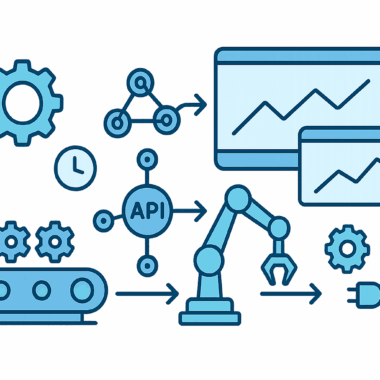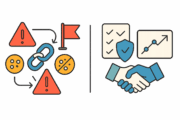

How to Scale Your Affiliate Program with Automation Tools

Content:
- Strategy & KPI Framework
- Tracking & Attribution Automation
- Partner Discovery & Recruitment Automation
- Onboarding & Enablement Automation
- Offer, Commission & Payout Automation
- Compliance & Brand Protection Automation
- Fraud Prevention & Risk Scoring
- Conclusion
- FAQ
Scaling an affiliate channel requires more than signing additional partners. Sustainable growth comes from replacing manual tasks with affiliate automation tools that standardize data, accelerate decisions, and protect margin. When instrumentation, workflows, and controls are codified, the program absorbs higher click volumes and more complex commissioning without adding headcount or risking accuracy.
This guide outlines a practical blueprint for automating the full lifecycle—strategy, tracking & attribution, recruitment, enablement, commissioning, compliance, and fraud prevention. Each section specifies what to automate, how to measure outcomes, and where to add guardrails. The result is a defensible operating model that scales across seasons, markets, and product lines.
Strategy & KPI Framework
Automation amplifies whatever strategy it encodes, so begin with a rigorous KPI framework. Define a north-star objective—incremental revenue growth, contribution margin, or CAC/LTV parity—and decompose it into operational metrics owned by specific roles. Publish a KPI dictionary with formulas, data sources, refresh cadence, and data stewards. This prevents debates about definitions and allows rules engines to act on consistent thresholds.
Make KPIs machine-actionable. Convert targets into configuration: acceptable lookback windows by partner type, minimum AOV for full credit, refund and chargeback ceilings, and payback guardrails. Trigger alerts when variance holds outside a tolerance band (e.g., ±10% for three consecutive days). Create a RACI for interventions so ownership is explicit when an alert fires.
Minimal KPI set (use as a baseline):
- Efficiency: CAC, contribution margin, payback period.
- Quality: New vs returning customer mix, refund/chargeback rate.
- Path value: Assisted conversion share, average touch position, incremental lift.
- Ops health: Time-to-first-sale for new partners, approval SLA, payout aging.
Implementation steps:
- Centralize KPI logic in BI/CDP; make the analytics model the source of truth.
- Expose thresholds to automation via config, not code, to speed iteration.
- Review KPI deltas in a weekly ops ritual; adjust rules with versioned change logs.
Tracking & Attribution Automation
Scale collapses when conversions are misattributed. Harden instrumentation with server-to-server postbacks, idempotent conversion IDs, cross-domain handling, and privacy-safe identity stitching where permitted. Version your event schema and validate payloads at ingestion. Queue webhooks with retries and exponential backoff to absorb traffic spikes while avoiding duplicates.
Automate attribution policies so they apply consistently. Use partner-specific lookback windows, channel priority to prevent paid search collisions, and position-based weighting for content touchpoints. Reconcile totals nightly across tracking, analytics, and finance; open an incident automatically when variance exceeds a defined threshold. Log the rule applied to every conversion to accelerate dispute resolution.
Control matrix (example)
|
Automation Area |
What to Automate |
Primary Metric |
Trigger Signals |
|
Postbacks |
Retry + dedupe by order ID |
Delivery success rate |
5xx response, timeout |
|
Lookbacks |
Window by partner category |
Validated conversions |
Coupon/tool-bar tag |
|
De-duplication |
Channel priority rules |
Double-count rate |
Paid search collision |
|
Reconciliation |
Totals vs BI/Finance |
Variance <1% |
EOD ledger compare |
Checklist to enforce:
- Require order ID, net revenue, currency, tax, consent string in every conversion.
- Produce daily path-to-conversion summaries for top partners and campaigns.
Partner Discovery & Recruitment Automation
Unfiltered outreach fills the roster with low-fit publishers and future compliance work. Replace volume emails with ICP-driven scoring that evaluates audience overlap, traffic provenance, geography, content quality, and commercial intent. Pull candidates from marketplaces, referrer analytics, and social graphs; only high-fit prospects enter a sequenced invite flow.
Turn recruitment into a governed funnel. Automate KYC and traffic checks at application, assign a probationary tier, and provision starter assets instantly upon approval. Calendarize performance reviews at day 14 and day 30 with promote/pause criteria. Capture structured rejection reasons to improve the scoring model and prevent retrying low-quality sources.
Signals that predict partner fit:
- Audience/category alignment and search intent match.
- Clean traffic (low data-center ASN share, stable geo mix, consistent CTR).
Recruitment flow (numbered):
- Ingest candidates → score → qualify.
- Send tiered invite sequence with clear expectations and incentives.
- Auto-provision tracking, deep links, and a curated creative pack.
- Review early performance; upgrade, coach, or pause.
Onboarding & Enablement Automation
Revenue stalls when activation depends on manual hand-holding. Build self-serve onboarding: a link builder, deep-link validator, coupon assignment, and a creative library with expiry metadata. Add pre-flight checks that confirm pixel firing, postback acknowledgment, and product feed completeness (availability, price, currency). If a check fails, display a prescriptive fix path in the partner portal.
Enablement should continue post-launch. Automate drip campaigns with seasonal calendars, top-converting categories, and copy templates by geography and tier. Push offer updates via webhooks so banners and feeds update ahead of promotions. Track time-to-first-sale and time-to-first-$1,000 as onboarding KPIs and iterate content to reduce both each quarter.
Enablement essentials (bulleted):
- Dynamic product feeds with inventory and price; hourly/daily refresh.
- Creative expiration alerts with automatic safe replacements.
- Sandbox mode for testing deep links without contaminating reporting.
- Searchable knowledge base with concise video walkthroughs.
Offer, Commission & Payout Automation
Flat rates reward proximity, not value. Implement a commission rule engine that factors SKU margin, customer status (new vs returning), geography, and payment method risks. Encode contribution thresholds—e.g., content partners need a minimum assist share or path position to unlock bonuses. Schedule automatic approvals, invoice generation, and reconciliation to compress cycle time and reduce disputes.
Operational finance needs strong guardrails. Automate clawbacks for returns and cancellations based on ERP feeds; withhold pending payouts when fraud or policy violations trigger. Monitor payout aging with alerts at 15/30/45 days. Provide partners with a ledger that shows rule hits per conversion, so explanations are transparent and appeals are evidence-based.
Commission automation playbook:
- Tie bonuses to incrementality (new-to-file, new category, higher margin SKUs).
- Cap assisted credit to contain multi-touch cost.
- Apply SKU/category exclusions or haircuts to protect contribution.
- Publish a changelog whenever commission logic updates.
Compliance & Brand Protection Automation
Brand damage scales faster than headcount. Instrument brand protection with keyword monitoring for SEM, domain/subdomain checks, and checkout code whitelists. When violations occur—brand bidding, unauthorized couponing, geo breaches—create a case automatically, attach evidence (screenshots, SERP logs), and place commissions on hold pending review.
Extend compliance across the lifecycle. Block prohibited content categories at onboarding, enforce disclosure requirements in flight, and keep immutable audit logs for legal and finance. Add graduated penalties and auto-deactivation for repeat offenders. Evidence-rich enforcement shortens investigations, deters abuse, and preserves ROI during promotional spikes.
Must-have controls:
- Checkout enforcement of whitelisted codes via API.
- SEM monitoring tied to progressive penalties and fast deactivation.
- Probation tiers for new partners with tighter thresholds and manual reviews.
Fraud Prevention & Risk Scoring
Fraud increases with scale unless detection layers keep pace. Deploy fraud prevention and risk scoring that combine device and IP reputation, ASN filtering for data centers, click velocity thresholds, and session integrity checks. Score events in real time, route high-risk traffic to manual review, and hold payouts until cleared. Tune thresholds to balance false positives against loss exposure.
Automate evidence management to resolve disputes quickly. Retain raw click and conversion logs for at least 24 months, hash sensitive identifiers, and expose partner-visible dashboards explaining adverse decisions. Re-score historical events when models improve; release or claw back funds accordingly. Track chargeback rate, approval latency, and CPA stability to prove control effectiveness.
Layered defenses (bulleted):
- Bot detection with human verification on suspicious bursts.
- Duplicate-order suppression by ID and device fingerprint.
- Geo-velocity checks and proxy/VPN identification.
- Partner-level throttling with progressive cooldowns.
Conclusion
Automation is the operating system for a high-scale affiliate program. Encode strategy as configuration, standardize tracking & attribution, and align commissioning with value, not proximity. Institutionalize compliance and fraud prevention so governance scales with volume. With these capabilities in place, your channel handles more partners, more offers, and more data while protecting margin.
Sequence the rollout to reduce risk: harden tracking, automate commissions, industrialize recruitment and onboarding, then layer risk controls. Measure impact per automation and retire manual steps once replacements prove stable. The compound effect is faster activation, cleaner data, and predictable unit economics across markets.
FAQ
Before diving into specific questions, frame support expectations. Automation does not remove oversight; it concentrates human effort on exceptions and strategy. Maintain review cadences, change logs, and rollback plans so automated decisions remain auditable.
The answers below focus on choices that often stall scaling efforts and outline practical trade-offs. Use them to build internal policies that legal, finance, and analytics can support without custom case-by-case intervention.
Do we still need analytics/BI if our platform automates reporting?
Yes. Use analytics/BI for cross-channel validation, cohort views, and incrementality estimates. Treat the affiliate platform as the payout ledger and reconcile totals nightly; keep variance under 1%.
What lookback windows are reasonable by partner type?
Coupon/tool-bar: 1–3 days. Content/influencer: 7–14 days. Subscription trials or high-consideration purchases: 14–30 days. Shorten windows during heavy brand campaigns to reduce channel collision.
Build vs buy for automation—what’s the right split?
Buy for common flows (webhooks, enrichment, notifications, ETL). Build when you need low-latency processing, proprietary fraud models, or deep coupling with internal pricing and inventory systems. Hybrid architectures work well when rules live in a configurable engine and heavy lifting runs in iPaaS.
How do we quantify ROI from automation?
Model savings from reduced manual work (hours × blended cost), lower overpayment via de-duplication and policy enforcement, and faster partner activation. Compare against software, integration, and maintenance costs. Report payback period and margin lift, not just top-line revenue.
How do we prevent bad automated decisions at scale?
Add guardrails: rate limits, change review queues, shadow-mode deployments, and instant rollback. Log every automated decision with the rule version and inputs. Keep manual overrides for critical payouts and partner status changes.

Common Affiliate Program Mistakes and How to Avoid Them
This article provides a practical, operations-first framework to diagnose failures and apply durable fixes. Each section outlines the symptoms to watch, the impact on unit economics, and specific countermeasures you can automate. The goal is a channel where KPIs, attribution, and fraud prevention work in concert, enabling scale without proportional headcount.

How to Choose the Right Affiliate Tracking Platform for Your Business
The article follows a practical structure used by performance teams during RFPs and pilots. You will define outcomes, test attribution models, validate integrations end-to-end, review SLA and security controls, and build a pricing/ROI view that survives legal and finance review. Every section includes concrete evaluation points you can paste into an internal checklist.



